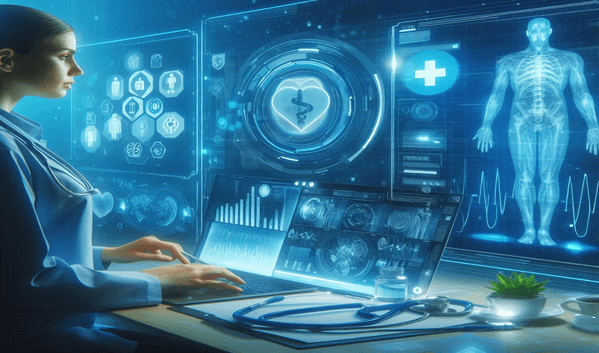Protecting Patient Data: The Growing Importance of Healthcare Cybersecurity
Published Date: 04 Nov 2024
In the modern world, technology has become a central tool by which healthcare organizations store patient information, work efficiently, and treat patients. However, this same dependence positions them for attack, with cybercriminals particularly exploiting it. As patient information is, a valuable commodity in the dark web healthcare cybersecurity cannot be overemphasized. This blog post provides insight into why patient data should be protected, the consequences of poor cybersecurity practices, and the best practices to apply in protecting patient information.

The Current State of Healthcare Cybersecurity
The current data shows that cyber threats in healthcare are a growing problem and this is understood. This information is derived from the 2023 Verizon Data Breach Investigations Report shows that healthcare had the highest percentage of data breaches with 15%. These breaches are also evidently not limited to identity theft but may result in the disruption of services and therefore, have an impact on operational and financial aspects. The COVID-19 pandemic escalated the use of digital health records and telemedicine further enlarging the vector of cyber risks.
The Risks of Data Breaches
- Patient Trust:
Loss of trust is one of the enormous consequences of a data breach. Personal and medical records of the patient are supposed to be kept secret as much as possible. Loss of confidence can occur with patients and healthcare providers due to a breach; this can affect patient relations and compliance with treatments.
- Financial Consequences:
A breach of data may lead to significant losses financially in an organization dealing with healthcare. The study done by IBM for the cost of a data breach in the healthcare sector revealed that on average; they are likely to cost $10 million. This figure is about fines, legal expenses, and costs for recovery and response activities.
- Regulatory Compliance:
There are many rules and regulations in the healthcare industry including Health Insurance Portability and Accountability Act (HIPAA). A breach may result in severe penalties and sanctions from regulatory bodies, which push an institution’s resources to the limit.
- Operational Disruption:
Ransomware is an example of an attack that may bring operations in a healthcare organization to a standstill. When systems fail, it means that the treatment of the patients is prolonged or even stopped, not sparing human lives.
Guidelines when Handling a Patient’s Information
Proactive risk management, information technology governance, and the protection of the patients’ information compose the components that healthcare organizations need when applying multifaceted approaches to cybersecurity. Here are some essential practices:
- Conduct Regular Risk Assessments:
Scoping is another important activity in which potential vulnerabilities and threats should be assessed to determine the weaknesses in your cybersecurity position. This kind of approach offers an advantage to organizations since it prevents a situation from being exploited before surfacing.
- Implement Strong Access Controls:
Make certain that only those who are permitted to see such patient information do so. RBAC solutions that are available protect data on an employee-by-employee basis to ensure that an employee cannot gain access to data beyond his or her authority levels.
- Enhance Staff Training and Awareness:
The biggest, and still unfolding, threat source that involves a human element as one of the causes of data breaches is human errors. Continuing education for the employees plays an important role so they are able to identify threats like phishing and make sure that they refrain from the wrong handling of data.
- Utilize Advanced Security Technologies:
Get security solutions that will act as firewalls encrypt data, and recognize unauthorized attempts to penetrate the security of a computer system. All these technologies are effective in preventing or identifying cases of unauthorized access to sensitive information.
- Develop an Incident Response Plan:
An efficient and proper procedure to follow in case of an incident may also reduce the extent of a disaster. This plan must cover actions that one has to take to mitigate the breach, evaluate the losses, and inform affected people as well as meet legal demands.
- Regular Software Updates and Patching:
Ensuring that all programs and networks are updated has to always be done to prevent or counter well-known risks. Also, specialize in the frequency of change by setting a regimen that would enable the update and the patching of all the systems in the network.
- Secure Third-Party Vendors:
Most healthcare centers contract third parties to offer the products and services they need. One needs to perform proper security evaluations of these third parties to ensure they have adequate security measures to protect your business.
Healthcare Cybersecurity in the Future
In addition, while new technologies keep on emerging, one can be very sure that hackers will keep on amping up their strategies too. As such, healthcare organizations must always stay on alert and change their approach to cybersecurity constantly. An implication is that resorting to progressive technologies, including artificial intelligence and machine learning, will improve threat detection and response.
However, it is also important to establish security awareness for every newly employed worker and staff. When prioritized, cybersecurity assures the security of personal information and fidelity to healthcare institutions, which leads to the quality of care for patients.
Conclusion
As data becomes more and more involved in the delivery of healthcare services, it is more important now than ever to safeguard patient data. Using examples of the dangers of leaking personal information, we can learn about the means that can help to protect the information and the reliability of healthcare organizations. It effectively transforms the commitment to cybersecurity into much more than the mere defense of data, as it also builds up the general structure of healthcare to become a safer place for all – from patients to healthcare workers.
Maximize your value and knowledge with our 5 Reports-in-1 Bundle - over 40% off!
Our analysts are ready to help you immediately.
